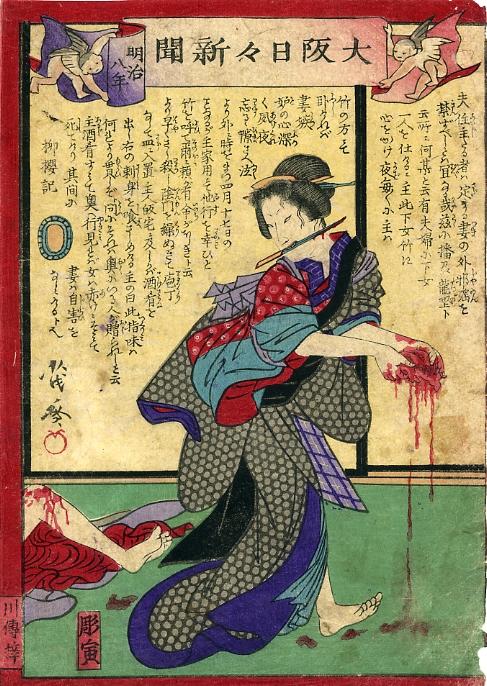
|
Series: Osaka nichinichi shinbun
Number: Meiji 8-nen [unnumbered]
Story date: a1875-4-15
Story source: not given
Publisher: Kawaden
Drawer: Shigehiro
Carver: Horitora
Writer: Ryuo
Size: vertical chuban
Image: Yosha Bunko
|
Osaka nichinichi shinbun
Meiji 8-nen [unnumbered]
Sashimi murder-suicide
"A husband should not allow his affections to stray to other women. A certain couple in Tatsuno, Banshu (present-day Hyogo prefecture) employed a female servant named Take. The husband fell in love with her and went to sleep with her every night. The wife was moved by deep jealousy and she spent her nights alone in tears. On April 15, while the husband was away, the wife summoned Take and stabbed her to death. She then gouged out the dead woman's genitals, sliced them and placed them on a platter. When the husband returned, she served it to her husband as hors d'ourvres. When he asked where the dish had come from, the wife replied, 'It was a gift from someone.' After he had finished the snack, he looked at his wife and saw her covered with blood and dead. While he had been eating, she had killed herself." (MS)
|
Censorship
Sashimi murder-suicide got a lot of negative attention. The 15 June 1875 issue (No. 126) of the Yomiuri shinbun reported the controversy over the print and noted that its publication had been stopped. The controversy over the print appears to have triggered a general tightening of control over the contents of news nishikie between July and August that year. It is not clear, however, whether further printings and sales were halted because the incident involved the family of a man of high rank, or the drawing was regarded as simply too sensational. (Tsuchiya 1995:128, and The Birth of News)
See
Apologies, Censorship, and Prohibition of Sales on the The Birth of News site for Tsuchiya's discussion of Sashimi murder-suicide and other news nishikie that were subjected to official scrutiny.
See Morality and Censorship for a discussion of Sashimi murder-suicide in light of the putative objectives of news nishikie to morally enlighten women and children, and as an inversion of the Abe Sada case of 1936. (WW)
